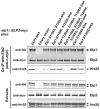Phosphorylation of Elp1 by Hrr25 is required for elongator-dependent tRNA modification in yeast
- PMID: 25569479
- PMCID: PMC4287497
- DOI: 10.1371/journal.pgen.1004931
Phosphorylation of Elp1 by Hrr25 is required for elongator-dependent tRNA modification in yeast
Abstract
Elongator is a conserved protein complex comprising six different polypeptides that has been ascribed a wide range of functions, but which is now known to be required for modification of uridine residues in the wobble position of a subset of tRNAs in yeast, plants, worms and mammals. In previous work, we showed that Elongator's largest subunit (Elp1; also known as Iki3) was phosphorylated and implicated the yeast casein kinase I Hrr25 in Elongator function. Here we report identification of nine in vivo phosphorylation sites within Elp1 and show that four of these, clustered close to the Elp1 C-terminus and adjacent to a region that binds tRNA, are important for Elongator's tRNA modification function. Hrr25 protein kinase directly modifies Elp1 on two sites (Ser-1198 and Ser-1202) and through analyzing non-phosphorylatable (alanine) and acidic, phosphomimic substitutions at Ser-1198, Ser-1202 and Ser-1209, we provide evidence that phosphorylation plays a positive role in the tRNA modification function of Elongator and may regulate the interaction of Elongator both with its accessory protein Kti12 and with Hrr25 kinase.
Conflict of interest statement
The authors have declared that no competing interests exist.
Figures








References
-
- Otero G, Fellows J, Li Y, de Bizemont T, Dirac AM, et al. (1999) Elongator, a multisubunit component of a novel RNA polymerase II holoenzyme for transcriptional elongation. Mol Cell 3: 109–118. - PubMed
Publication types
MeSH terms
Substances
Grants and funding
- 097945/WT_/Wellcome Trust/United Kingdom
- BB/F019629/1/BB_/Biotechnology and Biological Sciences Research Council/United Kingdom
- BB/F019106/1/BB_/Biotechnology and Biological Sciences Research Council/United Kingdom
- BB/F0191629/1/BB_/Biotechnology and Biological Sciences Research Council/United Kingdom
LinkOut - more resources
Full Text Sources
Other Literature Sources
Molecular Biology Databases

